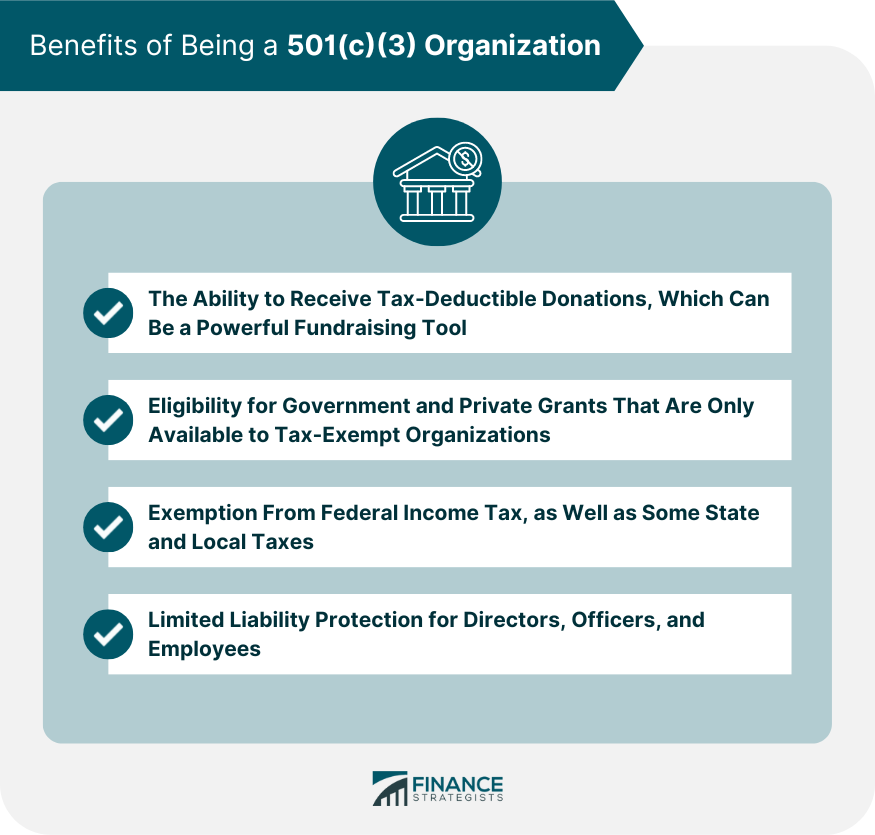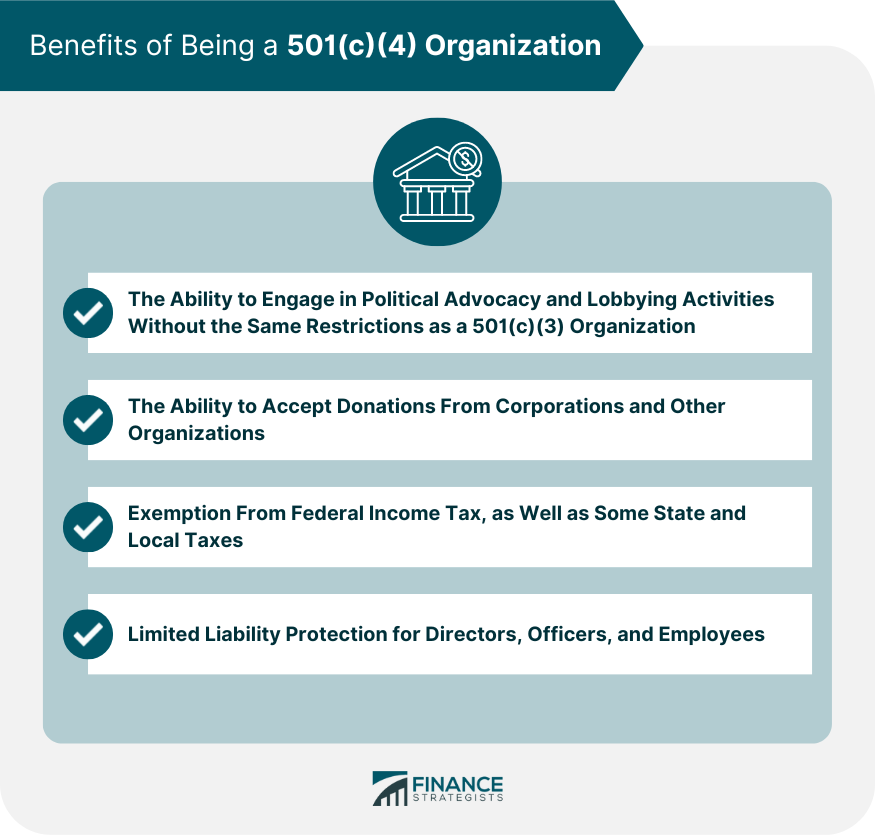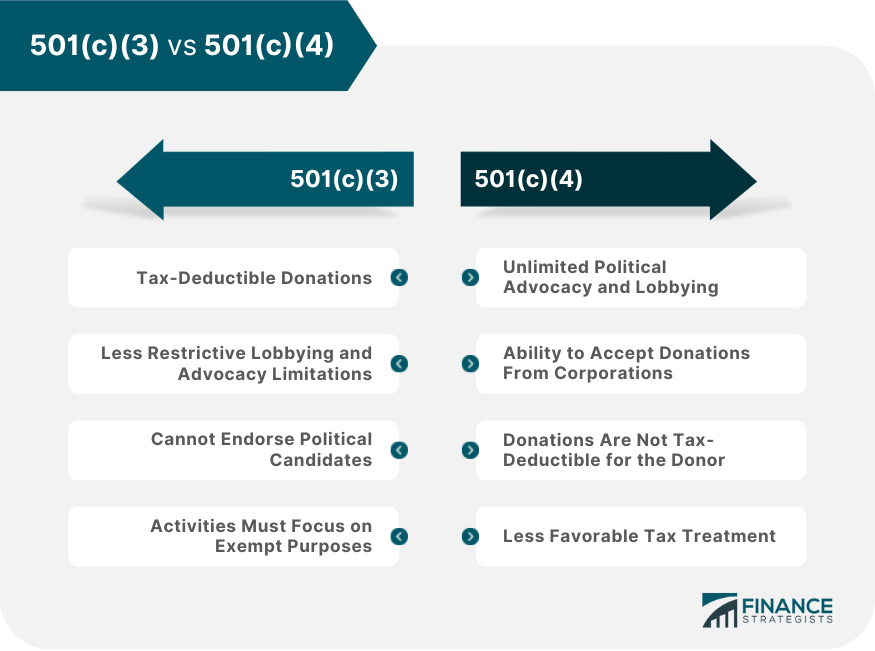501(c)(3) vs 501(c)(4): An Overview
Non-profit organizations in the United States are classified into various types, depending on their purpose and activities. The two most common types are 501(c)(3) and 501(c)(4) organizations.
501(c)(3) organizations are established for charitable, religious, educational, scientific, literary, or other specific purposes. They are also referred to as public charities, and their primary objective is to serve the public interest.
On the other hand, 501(c)(4) organizations are social welfare organizations that promote social welfare through civic, political, or other activities. They are allowed to engage in more political activities than 501(c)(3) organizations.
What Is a 501(c)(3) Organization?
A 501(c)(3) organization is a tax-exempt nonprofit organization that is eligible to receive tax-deductible donations.
These organizations are commonly associated with charitable, religious, educational, scientific, and literary endeavors. In order to qualify for 501(c)(3) status, an organization must meet certain eligibility requirements, including:
Being organized and operated exclusively for charitable, religious, educational, scientific, or literary purposes.
Restricting its activities to those that further its exempt purposes.
Prohibiting its earnings from benefiting any individual or private shareholder.
Examples of 501(c)(3) organizations include churches, schools, hospitals, museums, and charities.
Some well-known 501(c)(3) organizations include the American Red Cross, the United Way, and St. Jude Children's Research Hospital.

What Is a 501(c)(4) Organization?
A 501(c)(4) organization is also a tax-exempt nonprofit organization, but it has a different set of eligibility requirements and restrictions than a 501(c)(3) organization.
A 501(c)(4) organization is primarily focused on promoting social welfare, which can include political advocacy and lobbying. In order to qualify for 501(c)(4) status, an organization must meet the following requirements:
It must be operated exclusively to promote social welfare.
It must engage primarily in activities that promote the common good and general welfare of the community.
It must not be organized for profit, and its net earnings must be dedicated to social welfare purposes.
Examples of 501(c)(4) organizations include trade associations, civic leagues, and social welfare organizations.
Some well-known 501(c)(4) organizations include the National Rifle Association, the Sierra Club, and the League of Women Voters.

Key Differences Between 501(c)(3) and 501(c)(4) Organizations
While both 501(c)(3) and 501(c)(4) organizations are tax-exempt nonprofits, there are several key differences between them:
Tax-Deductibility of Donations
One of the most significant differences between 501(c)(3) and 501(c)(4) organizations is the tax deductibility of donations.
Donations to a 501(c)(3) organization are tax-deductible for the donor, which can be a powerful fundraising tool. Donations to a 501(c)(4) organization, on the other hand, are not tax-deductible for the donor.
Political Lobbying and Advocacy
501(c)(3) organizations are prohibited from engaging in political lobbying and advocacy activities, while 501(c)(4) organizations are allowed to engage in such activities.
This means that 501(c)(3) organizations cannot endorse or oppose political candidates or parties, and they must limit their lobbying activities to a certain percentage of their overall activities.
In contrast, 501(c)(4) organizations can engage in unlimited lobbying and advocacy activities, including endorsing political candidates or parties.
Tax Obligations
While both 501(c)(3) and 501(c)(4) organizations are exempt from federal income tax, there are some differences in their tax obligations.
501(c)(3) organizations are exempt from most state and local taxes, while 501(c)(4) organizations may still be subject to some taxes depending on the state in which they are located.
Additionally, 501(c)(3) organizations must file annual reports with the IRS, while 501(c)(4) organizations must file an annual Form 990 with the IRS.
Disclosure Requirements
501(c)(3) organizations are required to disclose certain information to the public, including their annual Form 990, their financial statements, and their list of donors. This information is available to the public on the IRS website and other online databases.
501(c)(4) organizations, on the other hand, are not required to disclose their list of donors to the public.
501(c)(3) vs 501(c)(4): Which Organization Should You Choose?
When deciding which type of nonprofit organization to set up, there are several factors to consider. If your organization's primary focus is charitable, religious, educational, scientific, or literary, then a 501(c)(3) organization may be the best choice.
On the other hand, if your organization's primary focus is on promoting social welfare through political advocacy and lobbying, then a 501(c)(4) organization may be the better choice.

501(c)(3) organizations offer the advantage of tax-deductible donations, which can be a powerful fundraising tool. They also have less restrictive lobbying and advocacy limitations than for-profit organizations.
However, they cannot endorse political candidates or parties, and their activities must be primarily focused on their exempt purposes.
501(c)(4) organizations offer the advantage of unlimited political advocacy and lobbying activities, as well as the ability to accept donations from corporations and other organizations.
On the other hand, donations to a 501(c)(4) organization are not tax-deductible for the donor, and they are subject to less favorable tax treatment in some states.
The Bottom Line
Understanding the difference between a 501(c)(3) and 501(c)(4) organization is essential for anyone who wants to set up a nonprofit organization in the United States.
These two types of organizations have specific eligibility requirements, tax implications, and restrictions on their activities. Choosing the right organization for your goals is critical to achieving success and maximizing the benefits of tax-exempt status.
501(c)(3) organizations are primarily focused on charitable, religious, educational, scientific, or literary endeavors and are eligible to receive tax-deductible donations.
501(c)(4) organizations are primarily focused on promoting social welfare through political advocacy and lobbying and are not eligible to receive tax-deductible donations.
The key differences between the two organizations include tax deductibility of donations, political lobbying and advocacy, tax obligations, and disclosure requirements. Hence, choosing the right organization depends on your organization's primary focus and goals.
It is imperative to choose the right organization because it affects your ability to fundraise, engage in certain activities, and receive tax benefits.
Setting up the wrong type of organization can lead to significant legal and financial consequences, so it is crucial to do your research and seek professional advice before making any decisions.
What Is the Difference Between a 501(c)(3) and 501(c)(4)? FAQs
A 501(c)(3) organization is a tax-exempt nonprofit organization that is eligible to receive tax-deductible donations. These organizations are commonly associated with charitable, religious, educational, scientific, and literary endeavors.
A 501(c)(4) organization is also a tax-exempt nonprofit organization, but it has a different set of eligibility requirements and restrictions than a 501(c)(3) organization. A 501(c)(4) organization is primarily focused on promoting social welfare, which can include political advocacy and lobbying.
The key differences between 501(c)(3) and 501(c)(4) organizations include tax deductibility of donations, political lobbying and advocacy, tax obligations, and disclosure requirements.
The choice between a 501(c)(3) and 501(c)(4) organization depends on your organization's primary focus. If your organization's primary focus is charitable, religious, educational, scientific, or literary, then a 501(c)(3) organization may be the best choice. On the other hand, if your organization's primary focus is on promoting social welfare through political advocacy and lobbying, then a 501(c)(4) organization may be the better choice.
To apply for tax-exempt status as a nonprofit organization, you must complete and submit Form 1023 (for 501(c)(3) organizations) or Form 1024 (for 501(c)(4) organizations) to the IRS. You must also pay a filing fee and provide supporting documentation.
True Tamplin is a published author, public speaker, CEO of UpDigital, and founder of Finance Strategists.
True is a Certified Educator in Personal Finance (CEPF®), author of The Handy Financial Ratios Guide, a member of the Society for Advancing Business Editing and Writing, contributes to his financial education site, Finance Strategists, and has spoken to various financial communities such as the CFA Institute, as well as university students like his Alma mater, Biola University, where he received a bachelor of science in business and data analytics.
To learn more about True, visit his personal website or view his author profiles on Amazon, Nasdaq and Forbes.











